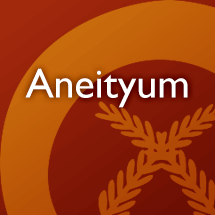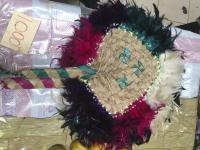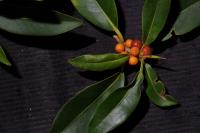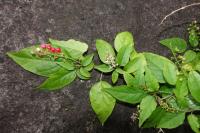An example search has returned 100 entries
ehlek
v. to seek food, as taro; to gather, to reap
bookmarkereuc
v. to shake a branch; to make fruit fall. pl: "ereucereuc"
bookmarkerijai
v.n. to rise up; to overflow as sea on land; to get ashore
bookmarkincat tal
n. basket of taro
bookmarkinceiwad
n. the name of a poisonous plant
bookmarkincetcai
n. a bundle of wood for fire
bookmarkincispev
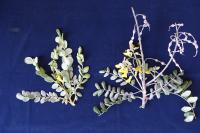
n. tree, 3 m tall (collection: Gregory M. Plunkett #3547)
Example: This plant is for medicine to treat a spiritual condition related to the coral snake that is the seawater spirit. When a woman is pregnant, some times she gets sick, so use this leaf with 2-3 other unspecified leaves and mash them together, squeeze the juice into a small cup (bamboo), wave around the woman’s body, and then put a few drops onto her head and body, then she drinks the rest. This will help heal her sickness. This treatment can be used for men who have a toothache from eating too much fish--the seawater spirit of the coral snake makes the tooth hurt. It is used in the same way as for a pregnant woman. If the pain from the toothache is really from the seawater spirit, then this will cure it; if not, it will not help.
bookmarkindroumu
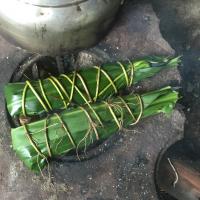
inhelegaij
n. kind of sugarcane; also "nalgaij"
bookmarkinholai mobo
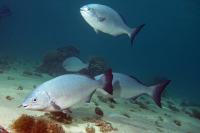
n. Brown Chub, Grey Sea Chub, Grey Drummer
Example: Photo by John Turnbull, License: CC BY-SA 3.0 via Fishes of Australia
bookmarkinja

n. Moorish idol
Example: Photo by Ian Shaw / iNaturalist.org, License: CC BY-NC 3.0 via Fishes of Australia
bookmarkink

n. vine, growing in coastal forest. Fruits purple. (collection: Gregory M. Plunkett #3556)
Example: A man named Johnnie (Reuben’s grandfather) brought this vine to Aneityum to use it as a rope to tie objects. The ripe fruits are used to paint the face and hands and children make drawings from this dye.
bookmarkinmeraducai
n. kind of breadfruit
bookmarkinmoijeuv ahcil
n. false star
bookmarkinmowad itouga

n. vine climbing on Geissois denhamii (GMP #3522), growing in open (collection: Gregory M. Plunkett #3524)
Example: The word itougo means from a different country or place outside of Aneityum. The plant was introduced by the first missionaries who came to Port Patrick. Calendar plant – sea cost people see this flower in the forest and they know it is time to go into garden and harvest taro or make new gardens– see GMP 3263. This is also good firewood.
bookmarkinp̃al

n. treelet or shrub, 1 m tall (collection: Gregory M. Plunkett #3204)
Example: To treat a headache, people traditionally would make a small cut ¼ inch long with a bamboo or piece of glass around the eyebrows where it is soft and then drip juice of the crushed leaves in the cut to take away the pain. Let the cut bleed first and then put the juice in it and it will stop the pain. The bleeding will stop the pain and the leaf juice will stop the bleeding – sometimes the pain will go away immediately and sometimes it takes a few minutes. So this technique is used to treat a very strong headache like a migraine.
bookmarkintaetled
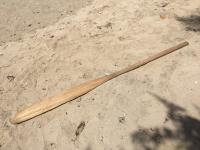
intal athunwai
n. kind of taro
bookmarkintapin
n. a hedge; a shelter
bookmarkintel e cha

n. terrestrial orchid, growing in open (collection: Gregory M. Plunkett #3523)
Example: This is a "message plant." If a person puts the flower behind their ear and then stares out at you, or tosses the flower to you, then say yes and follow them, for example, to drink kava, or to go swimming. Or a man invites a woman to go somewhere with him. Alternatively, you can leave the flower on a table and this is also a message to go with a person. Leaves also used to wrap foods. Decorate yard around the house.
bookmarkintesyanam̃a

intinan
n. a bed, a foundation, a plantation
bookmarkintowosjei

inyac
n. kind of plant, grass, or fern
bookmarkjigkom
[ʧiŋkum] n. chewing gum
bookmarkkidibop

naha
n. a thistle
bookmarknahein
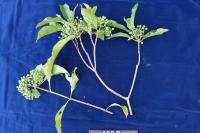
n. shrub to 1 m tall, frits green. Red clay soil (collection: Michael J. Balick #4880)
Example: Stems are used to produce cyclone houses--secure wild cane (Miscanthus) on the roof of the house. Fold cane in half over the stem of this plant and then lay it on the roof. Makes layers that resist the wind. The stem of this plant can be sharpened to make a fishing spear, or used as the shaft and a few wires are attached to the end.
bookmarknahoijcei
n. the name of a species of creeper
bookmarknahtancai upunupun
n. thorn
bookmarknaligaj
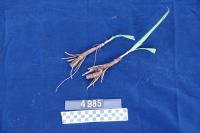
n. herb to 10 cm, sterile (collection: Michael J. Balick #4985)
Example: This plant is a very important food during a famine. People dig up the roots and roast these on the embers of a fire for 25 minutes, then check the root to get out the starchy material, and spit out the fiber. There is said to be little taste; this is a bland food that a person eats to survive. People on Aneityum have harvested it for a very long time so there is not as much of a supply left as in the past.
bookmarknamehe
n. kind of taro
bookmarknatoga ahrei
n. wind-related term; no definition provided
bookmarknecemas

n. fern to 30 cm, cones green (collection: Michael J. Balick #4919)
Example: Use this plant to send a message to someone that another person has died. Take 1 dried leaf, to pass message to another village/tribe or people. Hold it in your hand and walk past a person, then they know that someone has died.
bookmarknedec
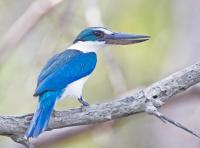
[neθeɣ] n. Collared Kingfisher
Example: Photo by JJ Harrison, License: CC BY-SA 3.0 via Wikimedia Commons
bookmarkneduon yau
n. kind of banana
bookmarknehpan neaig
n. kind of plant, grass, or fern
bookmarknejev

n. Skipjack tuna
Example: Photo by Krw130lm / Fishes of Australia, License: CC BY-A-SA 3.0 via Fishes of Australia
bookmarknejev
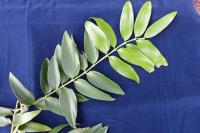
n. tree, 8 m tall (collection: Gregory M. Plunkett #3214)
Example: This tree makes good wood for canoes as well as timbers that are cut for building houses. A decoration that is placed around the head, known as salu-salu is made from these leaves. If you wear it, people know you are from Aneityum. In the early 1950’s-1960’s, Aneityum was the main place for logging this species. Now it is rare and in need of replanting. A project from New Zealand planted pine trees in its place and they have thrived here. In the same way, the sandalwood tree was overharvested and is rare now. Timber, very resinous so good to start fire – branches good for fire. They are the ones that have the sap, if a person in in the bush and finds young tree – sapling – they will make headdress from the leaves to show they came from the bush. Also, this is a Kastom name.
bookmarknepahas
n. kind of tree
bookmarkneyo
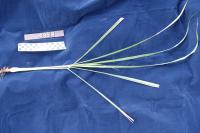
n. grass to 70 cm tall, sterile. Cultivated at the side of a field. (collection: Michael J. Balick #4958)
Example: The leaves and stems are boiled in water to make tea. The base of the leaves (the whitish part) is used to cook foods that have a strong odor, such as goat or shark. The base is sliced and put in the soup and this helps to keep the smell of the goat or shark from infusing through the rest of the food and making it less palatable. In some areas of Aneityum, such as in cassava fields, there is a fungus that kills the crops. This species is interplanted with the crops to kill that fungus and protect the crop plants.
bookmarkniegred
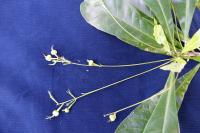
nijwou
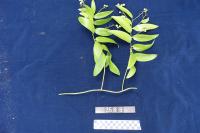
n. vine climbing up a macaranga tree, growing in open disturbed area. Fruits green. (collection: Gregory M. Plunkett #3588)
Example: 1. To build a cyclone house, take the vine of this species to tie pieces of the house. To prepare the vine for use as rope, collect many feet of it, put it in a fire, roll it in a figure 8, wait until it softens and then use for tying. This vine is hard and needs to be heated to a high temperature in the fire to make it soft; the person preparing this must use gloves to tie it to the posts and rafters while it is still warm. When it cools, it is very strong. Rope made from this vine will last a long time--perhaps 10-15 years. It can also be used to make a regular house. However, it is not as strong as GMP #3589. 2. For men who want rasta in hair, take a few leaves and dry them, burn with some other plants to rub on the rasta and keeps it healthy, keep from splitting.
bookmarknilpodou
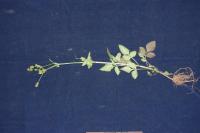
n. herb, growing at edge of garden area. Flowers yellow. (collection: Gregory M. Plunkett #3599)
Example: This is for a medicinal tea to give energy to a person who is not feeling well. Collect a handful of young stem apices and boil in 2-3 cups of water. Drink warm to help the body be strong and healthy. It is also good to treat diarrhea. When a person feels well again, stop this treatment but they can also drink this 1x daily, once before breakfast or before lunch, as a healthful tea.
bookmarknirac intam henain

niridunumu
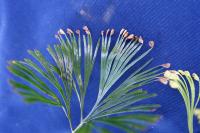
niridunumu
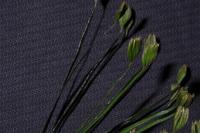
n. terrestrial fern, growing along ridge in dense rainforest. (collection: Gregory M. Plunkett #4121)
Example: 1. The name means "fish gill". When one acquires a culture-bound illness, caused by possesion of the sea devil, this plant is used to prepare a remedy. Further information about the illness and remedy withheld.
bookmarknohmun wai
n. bank (of a river)
bookmarknohor
n. kind of taro
bookmarknuae

nunyepec
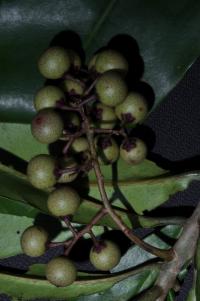
n. understory tree, 6 m tall (collection: Gregory M. Plunkett #4049)
Example: 1. The name means "knife of sandpaper", a type of fish. The leaf base resembles the fin of the fish. 2. In the past, a spear was made from the sapling wood of this plant for tribal warfare. Today, spears are made from this plant for fishing. First, a relatively straight spaling is chosen and then heated over a fire. The pliable portion of wood is straightened and then decorticated. When cool, a portion of wire can be affixed on one end to aid in the spearing of fish.
bookmarknupyihet
n. new moon
bookmarkrap̃ad
[rak͡pad] n. black hawk
bookmarkromo romo
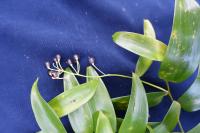
n. vine to 1 m, fruits black. Secondary forest. (collection: Michael J. Balick #4906)
bookmarktapasetarayi
n. kind of taro
bookmarkunasuandan
upumure
v.n. to fall, as unripe fruit
bookmarkuriicai
adj. made of branches
bookmarkyetse
v.n. to go down
bookmark